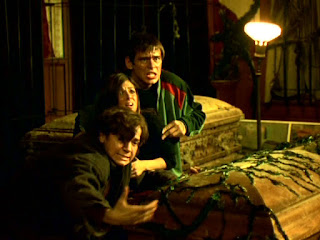"The sciences, each straining in its own direction, have hitherto harmed us little; but some day the piecing together of dissociated knowledge will open up such terrifying vistas of reality, and of our frightful position therein, that we shall either go mad from the revelation or flee from the deadly light into the peace and safety of a new dark age."- H.P. Lovecraft
I've been on sort of a downer lately - two posts criticizing movies I felt fell short (or apart), and then a post praising one of the most disturbing and bleak films in recent history. I want to lighten things up a bit, so this week I want to talk about an adaptation of a story by H.P. Lovecraft.
Yes, H.P. Lovecraft is "lightening things up a bit."
The Call of Cthulhu is an adaptation of the short story by the same name, and is easily one of the better adaptations of Lovecraft's work I've seen. I have a soft spot for his particular brand of cosmic horror - the idea that there are monolithic alien…things…lurking out there in the dark, really resonates with me. It's a good spin on the "things are much worse than you originally thought" approach to horror, upping the stakes from the merely supernatural to something bigger and less easily comprehended. Ghosts? No problem - put their soul at rest. Werewolves? Pshaw - make some silver weaponry and you're all set. Vampires? Crosses, garlic, sunlight…or, in the case of the Twilight stories, puberty.
But ancient creatures from beyond time and space, waiting on the fringes of reality to devour us all? You are straight-up fucked.
Unfortunately, Lovecraft's stories haven't always aged well - they are a product of an older, more genteel time (albeit with some pretty appalling ideas about race and gender roles), and their florid prose and tendency to dance around the monstrous details can make them more quaint than frightening to the modern reader. Attempts to bring Lovecraft's stories into film usually involve a modern setting, and in my (limited) experience tend to suffer as a function of low budgets - it's hard to scare people with monsters from beyond time and space when you can see the strings and zippers. The ideas themselves are pretty timeless, it's the aesthetic and technical constraints that limit their impact.
The people who made The Call of Cthulhu found an inventive way around both of those. The film is made in the style of a silent film - it is The Call of Cthulhu as it would have been presented at its time of publication, neatly circumventing the problem of language and making budgetary constraints entirely period-appropriate. We're seeing a horror film as it would have been in its time, had it existed - like a piece of speculative fiction come to life. So that's pretty ambitious.
Equally ambitious is the story they're tackling - The Call of Cthulhu takes place mostly within nested flashbacks as three separate narratives, each of which occurs as a piece of a larger story being assembled by a narrator as he reviews the notes of his deceased granduncle. A strange sculpture made by a delirious artist in Rhode Island, a bizarre, primitive ritual in New Orleans, a narrow escape from death on an expedition to Greenland, a drifting, derelict ship, occupied by a sole surviving crewman - what connects all of these things? As the narrator reads these accounts, we see them played out on the screen. As he pieces it together, so do we, coming to realize what the implication is - what horrible thing is waiting to rise out there. We are even allowed to share in the narrator's nightmares and hallucinations.
The use of a silent film style here isn't quite note-perfect - there are still a few little things here and there which give away its more modern origins, but not many. The acting is appropriately over-expressive, the titles and captions equally hysteric. The makeup and lighting are stark, expressionistic at times. Everything about the aesthetic was absolutely necessary in the age of silent films; in a modern context it lends everything a slightly alien feel (only too appropriate for the subject matter). When the story really picks up steam (with the tale of the derelict ship), the effects used to depict the intrusion of another world into our own are both period-appropriate and inventive - it would have been the Lord of the Rings of its time. As I watched the climax, I found myself saying "man, people would have been shitting themselves at this in 1928."
This probably isn't the result you want for a horror movie - admiring detachment isn't the same thing as fright, and this is not the scariest movie I've ever seen. "Spooky" is probably a better description. But as a diversion from more direct, intense, uncompromising modern films, it is refreshing. As a silent film, it marries form with intent, it handles an ambitious narrative economically, and it brings a classic horror story to life in a way that a modern adaptation couldn't.
It takes us on a journey - a glimpse into an alternate past where the latest from H.P. Lovecraft was the most-anticipated horror film of the year. And after a couple of really shitty movies (both of which borrow from Lovecraft to varying degrees of formality) and one which, while a solid, worthwhile piece of art, is horror as far from cosmic as you can get, illustrating every ugly corner of the human psyche - well, this was like settling in with a glass of wine and a favorite old book or radio play. A reminder of another time, comforting in form as discomforting in intent. The peace and safety of a new dark age.
IMDB entry
Purchase on Amazon.com
Available on Netflix





